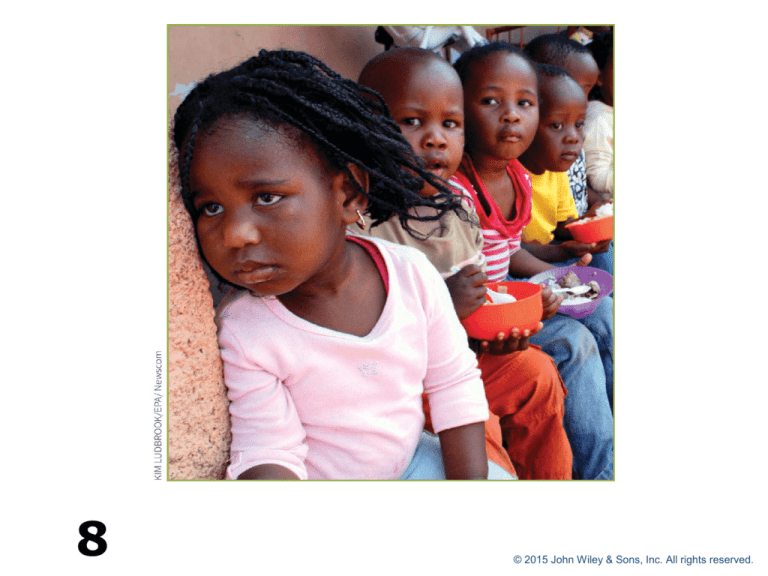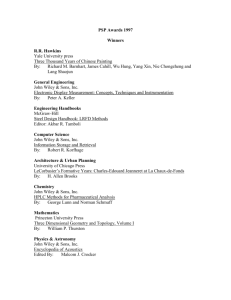
The Human Population
8
© 2015 John Wiley & Sons, Inc. All rights reserved.
Overview of Chapter 8
• The Science of Demography
• Demographics of Countries
– Demographic Stages
– Age Structure
• Population and Quality of Life
• Reducing the Total Fertility Rate
• Government Policies and Fertility
© 2015 John Wiley & Sons, Inc. All rights reserved.
Africa and population growth
• Population of Africa growing rapidly
• Population estimates decreased due to
HIV/AIDS infection rates/deaths
70% new infections within subSaharan Africa
Many children orphaned from
death of parent(s)
Average life expectancy
dropped by 10 years
As health of citizens decline,
labor shortages occur
© 2015 John Wiley & Sons, Inc. All rights reserved.
The Science of Demography
• Demography
– Branch of sociology that studies population
statistics, structure and growth
• Human Population since 1980 is J-shaped
curve (7.1 billion in 2014)
© 2015 John Wiley & Sons, Inc. All rights reserved.
Human Population Growth
• Human population reached:
–1
–2
–3
–4
–5
–6
–7
billion
billion
billion
billion
billion
billion
billion
around 1800
in 1930
in 1960
in 1975
in 1987
in 1999
in 2011
© 2015 John Wiley & Sons, Inc. All rights reserved.
Human Population Growth
• Population is increasing due to decrease in
death rate, not increase in birth rate
– Greater food production
– Better medical care
– Improvements in water quality and sanitation
• Growth rate (r) has started to
decline
– Will continue to decline until “zero population
growth”….but when will ZPG be achieved????
– S-curve may replace J-curve
© 2015 John Wiley & Sons, Inc. All rights reserved.
Carrying Capacity
• Carrying Capacity (K)
– The maximum number of individuals of a
given species that a particular environment
can support for an indefinite period,
assuming no changes in the environment
(Ch 5)
• Both environmental constraints and
human values have an impact on K
• Uncertain what the carrying capacity of
the Earth is for humans
© 2015 John Wiley & Sons, Inc. All rights reserved.
Current and Future Population Numbers
• Projections for 2050
– Low = 8.3 billion
– High = 10.9 billion
– Most likely = 9.6
billion
• Projections have
increased since
2012 by ~ 0. 5
billion
© 2015 John Wiley & Sons, Inc. All rights reserved.
Estimating Future Populations…
• Determining the number of years a
population will double provides a quick
analysis about the population (country)
itself, and uses the following formula:
– Td (Time for doubling) =
70/r
• Where r = growth rate in PERCENT
• EXAMPLE: Pakistan population in 2016 = 191
million, with a growth rate of 2.1%
• 70/2.1 = 33.3 years, indicating that the
population will double by the year 2049 (382
million people)
© 2015 John Wiley & Sons, Inc. All rights reserved.
Determining Future Populations
• Final Population = Initial Population X e(rt)
Pf = Pi x e(rt)
• Where:
• e = 2.7183 (physical constant)
• r = growth rate (in decimal form)
• t = number of years later that you are
calculating
• EXAMPLE: USA population in 2016 = 317.7 million
• What will be the USA population in 2040?
© 2015 John Wiley & Sons, Inc. All rights reserved.
Determining Future Populations
Pf = Pi x e(rt)
• USA population in 2016 = 317.7 million
• What will be the USA population in 2040
given the current growth rate of 0.4%?
P2040 = 317.7 x 2.7183(.004 x 24) = ?????
= 349.7 million
© 2015 John Wiley & Sons, Inc. All rights reserved.
Demographics of Countries
© 2015 John Wiley & Sons, Inc. All rights reserved.
Population Growth in Developing
versus Developed Nations
• Population growth and population
characteristics are not the same in all
countries
© 2015 John Wiley & Sons, Inc. All rights reserved.
Replacement Level Fertility
• Number of children a couple must have to
“replace themselves”
– 2.1 children
• Total fertility rate worldwide is 2.5
children
– More than replacement level fertility
© 2015 John Wiley & Sons, Inc. All rights reserved.
Birth rates around the world
© 2015 John Wiley & Sons, Inc. All rights reserved.
Demographic Stages
• Pre-industrial Stage
– Birth and death rates high, modest
population growth
• Transitional Stage
– Lowered death rate, rapid population growth
• Industrial Stage
– Birth rate decline, population growth slow
• Postindustrial Stage
– Low birth and death rates, population growth
very slow
© 2015 John Wiley & Sons, Inc. All rights reserved.
Demographic Stages
© 2015 John Wiley & Sons, Inc. All rights reserved.
Fertility Changes in Developing
Countries
© 2015 John Wiley & Sons, Inc. All rights reserved.
Age Structure Diagrams
The SHAPE of an age structure diagram (also known as a “Population Pyramid”)
can be used to indicate several societal factors in a country.
Generalities can be made such as
Wealth/poverty status
Access to medical care facilities
Sanitation and water availability
Infant mortality
Role of women/access to contraception
Disease rates
Levels of education/literacty
Popultion growth momentum
ETC.
© 2015 John Wiley & Sons, Inc. All rights reserved.
Age Structure Diagrams
© 2015 John Wiley & Sons, Inc. All rights reserved.
Age Structure
• Population Growth
Momentum
– Potential for future
increases or
decreases in a
population based on
current age structure
– Increase seen when
largest population is
in pre-reproductive
age group (26% of
world population)
© 2015 John Wiley & Sons, Inc. All rights reserved.
Age Structure
• Low fertility rate
usually leads to larger
elderly population
– Most are retired - not a
part of workforce
– Increase on country’s
tax burden
– High percentage of
disabled or chronically ill
© 2015 John Wiley & Sons, Inc. All rights reserved.
Effects of aging population
• Japan- Longest life
expectancy
– Men 80; women 86
– Low fertility rate and fears that
young may not support elderly
– Incentives to continue working
past retirement
•
Russia has fertility rate of 1.7
– Declining population
– Incentives for young to start
families
• A new problem for the world
© 2015 John Wiley & Sons, Inc. All rights reserved.
Population and Quality of Life
• Difficult to meet basic needs in developing
countries
• Problems associated with overpopulation:
– Environmental degradation, Hunger, Persistent
poverty, Economic stagnation, Urban
deterioration, Health issues
• Can Earth sustainably support 9.6 billion
people?
– Depends on quality of life,
– People, businesses, governments changing
habits
© 2015 John Wiley & Sons, Inc. All rights reserved.
Population and Chronic Hunger
• Food security
– Condition in which people DO NOT live in
hunger or fear of starvation
• Effects of Chronic Hunger
– Weakened immune system
– Illness and disease
•
•
•
•
Malaria
Measles
Diarrhea
Acute respiratory illness
© 2015 John Wiley & Sons, Inc. All rights reserved.
Population and Chronic Hunger
• Food insecurity
– Conditions under which people live with
chronic hunger and malnutrition
• Solving the Food Problem
– Control population growth
– Promote economic development of
developing countries without adequate food
supplies
– Provide assess to food and land resources to
those who live in areas without them
© 2015 John Wiley & Sons, Inc. All rights reserved.
Economic Effects of Population Growth
• Two viewpoints from economists:
– Population growth stimulates economic
development and technological innovation
– Rapid population expansion hampers
developmental efforts
• Most observations support the second
viewpoint
• In order for country to increase its
standard of living, its economic growth
must exceed its population growth
© 2015 John Wiley & Sons, Inc. All rights reserved.
Reducing the Total Fertility Rate
Three major influences on total fertility rate
1. Cultural traditions
2. Social & economic status of women
3. Family planning
© 2015 John Wiley & Sons, Inc. All rights reserved.
Cultural and Fertility
• Culture influences and
controls individuals’
behaviors
– Marriage age
– Due to high infant and
child mortality rates,
couple is expected to
have large number of
children
– Children often work in
family business
(pictured left)
– Religious values
© 2015 John Wiley & Sons, Inc. All rights reserved.
Social & Economic Status of Women
• Gender inequality is common worldwide
• Disparities
– Political participation
– Social status
– Economic status
– Health status
– Legal rights
– Education
– Employment and earnings
Illiteracy in 2002
Single most important factor affecting high total fertility rates is low status of women
© 2015 John Wiley & Sons, Inc. All rights reserved.
Educational Opportunities and Fertility
• Women with more
education
– Marry later
– Have fewer
children
© 2015 John Wiley & Sons, Inc. All rights reserved.
Family Planning Services
• Family planning services
– Services that enable both men and women to
limit family size, safeguard individual health
rights, and improve the quality of life for
themselves and their children
© 2015 John Wiley & Sons, Inc. All rights reserved.
Family Planning Services
• Recent trends….
– 78 developing countries in Africa, Asia, Latin
America, and the Carribean have prioritized
limiting population growth.
• These countries have policies such as economic
rewards and/or penalties to achieve this
• Healthcare, education, economic development,
improving women’s lives, are all part of the
process being used to limit population growth
© 2015 John Wiley & Sons, Inc. All rights reserved.
Government Policy and Fertility- China
• Largest population in the world
• Controversial Family Planning Policy
– 1971 - Chinese Government actively
pursued birth control
– 1979 - Incentives to promote later
marriages and one-child families
• Medical care, schooling for child, preferential
housing, retirement funds
– Brought about rapid and drastic decrease in
fertility
© 2015 John Wiley & Sons, Inc. All rights reserved.
Government Policy and Fertility- China
• 1979- plan put in place with incentives to
promote later marriages and one-child
families
• Incentives were medical care, schooling for
child, cash bonuses, preferential housing,
retirement funds
• If second child was born, all incentives must
be revoked or returned
• Decrease in fertility from 5.8 births per
woman to 2.1 birth per woman in 1981
© 2015 John Wiley & Sons, Inc. All rights reserved.
© 2015 John Wiley & Sons, Inc. All rights reserved.
Government Policy and Fertility- China
• Plan was controversial and unpopular
– Social pressure to abort a second child
– Pressure to abort/kill female first child
• 120 boys to 100 girls as of 2000
Plan
much more relaxed
in rural China
2013 TFR = 1.5
2016 update….China
has officially abolished
the 1 child policy.
Last October, China ended its 35-year-old policy of restricting most
urban families to one child. Commonly referred to as the "one-child"
policy, the restrictions were actually a collection of rules that governed
how many children married couples could have.
© 2015 John Wiley & Sons, Inc. All rights reserved.
Government Policy and Fertility- China
• Result of China’s one-child policy: a
smaller workforce to support the huge
aging population in China may lead to
significant economic struggles
© 2015 John Wiley & Sons, Inc. All rights reserved.
© 2015 John Wiley & Sons, Inc. All rights reserved.
© 2015 John Wiley & Sons, Inc. All rights reserved.
Government Policy and Fertility- Mexico
• Young age structure
– Huge potential for population growth: 30% of
population is under age 15
• High Population Growth Momentum
• 1974 - government imparted educational
reform, family planning, health care
– Very successful
– TFR dropped from 6.7 (1970) to 2.2 (2013)
© 2015 John Wiley & Sons, Inc. All rights reserved.
Millennium Development Goals
• 189 heads of state met at U.N. Millennium
Summit – address needs of impoverished
• Action plan –Millennium Development Goals
–
–
–
–
–
–
–
–
12345678-
Eradicate extreme hunger and poverty
Achieve universal primary education
Promote gender equality and empower women
Reduce child mortality
Improve maternal health
Combat HIV/AIDS, malaria, and other diseases
Ensure environmental sustainability
Develop a global partnership for economic development
© 2015 John Wiley & Sons, Inc. All rights reserved.
Achieving Population Stabilization
• How can developing country governments help?
– Increase $$ allotted to pubic health and family
planning services
Education on methods of birth control
Increase average level of education
How can developed country governments help?
Provide financial support
Supporting research and development of new birth control
methods
© 2015 John Wiley & Sons, Inc. All rights reserved.
Achieving Population Stabilization
Highly developed nations can have problems of
unsustainable consumption by affluent people
Polices to support sustainable choices?
Voluntary simplicity
Way of life that involves wanting and spending less
Downshifting
Voluntarily moving
from lifestyle based
on accumulation of
wealth and goods
Ex: Tiny houses
© 2015 John Wiley & Sons, Inc. All rights reserved.







